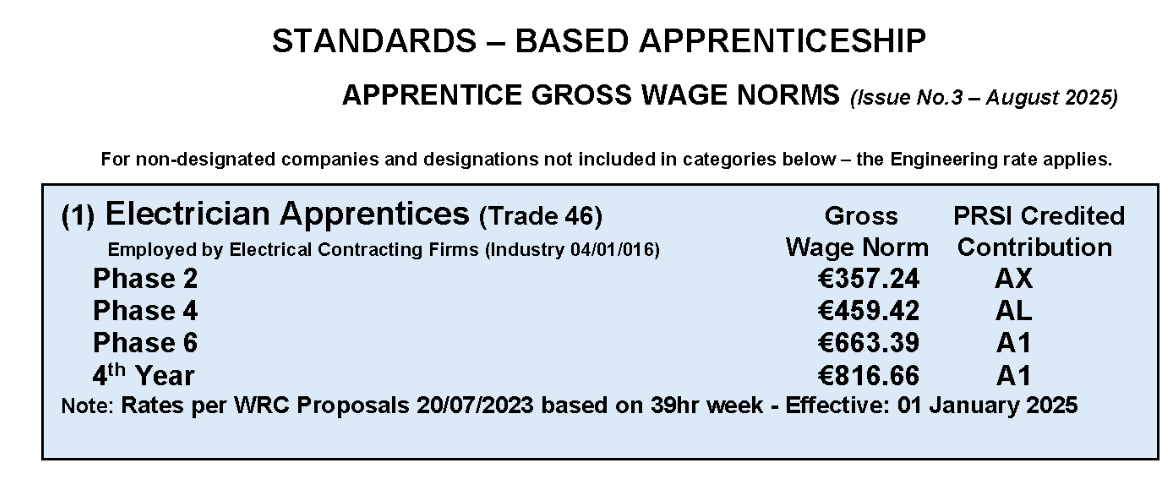In Summary
The work of an Instrumentation craftsperson involves the maintenance and repair of all instruments used in the measurement and control of process variables (e.g. in the chemical industry to measure and control the temperature, pressure and flow, as appropriate, in various points of the process).
The instrumentation craftsperson carries out installation, maintenance and calibration of measuring instruments, sensors, transmitting and controlling devices and systems associated with the measurement, control and protection of physical quantities found in these industries.
Click the photo above to view the Instrumentation brochure.
The measurement and control of these quantities enables products to be produced to specification, taking account of the safety of personnel, plant and equipment and the protection of the environment. Instrumentation craftspeople are employed in the installation and maintenance of measurement and control equipment in pharmaceutical, food and other industries.
View Occupation Profile from Apprenticeship.ie
To view full details of this occupation, view information from our Careers database for the following occupation: Instrumentation Craftsperson
Entry Requirements
The minimum age at which the employment of an apprentice may commence is 16 years of age.
The minimum educational requirements are:
Grade D or "Achieved" in five subjects in the Department of Education & Skills Junior Certificate Examination or an approved equivalent,
or
The successful completion of an approved Pre-Apprenticeship course,
or
Three years’ work experience gained over sixteen years of age in a relevant designated industrial activity as SOLAS shall deem acceptable.
You must obtain a job as an apprentice in your chosen occupation. Your employer must be approved to train apprentices and must register you as an apprentice within 2 weeks of recruitment.
In this apprenticeship applicants are required to pass a colour vision test approved by SOLAS.
Note: These are the current approved minimum educational requirements for apprenticeship programmes, however, previous experience of the following subjects would be an advantage but not essential:
- Technical Drawing/Graphics
- Physics
- Technology
- Mathematics
Please note: To become an instrumentation apprentice you must pass the Ishihara Colour Vision Test (24 Plate Edition). For further information, contact your local Education and Training Board
Training
Phase 1: With Employer
- Induction Training
- Introduction to Health & Safety
- Introduction to Tools & Equipment
- Introduction to Basic Skills
Phase 2: Delivered in Training Centre (24 weeks)
Course Content:
- Induction
- Basic Engineering
- Electrical 1
- Electronics 1
- Measurements - Pressure
- Measurements - Flow
- Measurements - Level
- Measurements - Temperature
- Final Control Elements
- Automatic Control
- Related Theory
- Work Based Training and Assessments
Phase 4: Delivered in Educational College (11 weeks)
- Electrical
- Electronics 2
- Measurements
- Final Control Elements
- Automatic Control
- Related Theory
- Work Based Training and Assessments
Phase 6: Delivered in Educational College (11 weeks)
Course Content:
- Digital Electronics
- Measurements
- Control Systems
- Related Theory
Phase 7: With Employer
- Work Based Training and Assessments
On successful completion of the programme the learner is awarded a Level 6 Advanced Certificate Craft – Instrumentation.
-
Further information is also available from your local Education and Training Board.
Skills & Qualities
As an Instrumentation craftsperson you will need to be physically active and to be able to work with your hands.
An awareness of health and safety and good housekeeping is essential as well as attention to detail and an eye for the aesthetic.
The Instrumentation craftsperson must have the ability to:
- Plan and organise
- Communicate effectively
- Solve problems
- Work independently and as part of a team
- Show a positive attitude
- Recognise the need for good customer relations
- Demonstrate good work practices including time keeping, tidiness, responsibility, quality awareness and safety awareness
Core Skills
- Installation, maintenance and calibration of process measurement and control equipment.
- Installation and maintenance of protection and safety shut-down systems in the process industry.
Specialist Skills
Installation and maintenance of:
- First-up Systems
- Shut Down Systems
- Analytical Instrumentation
- Telemetry
- Weighing Systems
- Vibration Monitoring
- Data and Scada Systems
- Information Gathering and Logging Systems
Note: A person wishing to become an apprentice Instrumentation Craftsperson must pass a colour–vision test approved by SOLAS .
Work Activities
- Learning and developing new practical craft-related skills, knowledge and competence
- Working with and learning from experienced craftspersons
- Working with electricity and electronics
- Comply with Health and Safety requirements
- Using mathematics to solve technical or scientific problems
- Being responsible for controlling or adjusting equipment
- Working on machines/processes
- Understanding technical drawings and diagrams
- Accuracy and attention to detail
- Being accurate with numbers in counting, measuring and arithmetic
- Keeping accurate records of all calibrations or reports
- Being well organised and careful with practical tasks
- Taking responsibility for their own learning, including the allocation of study time
- Being physically active
- Working with a variety of specialised hand tools, power tools and equipment
- Passing all your phase exams (theory, practicals skills demonstration)
- Earning as you learn
Career Progression
On successful completion of the apprenticeship programme, apprentices are qualified to work within the recognised trade or profession.
Opportunities arise from time-to-time for promotion to supervisor level. Many craftspersons use their apprenticeship qualification as a platform to launch careers such as engineers, managers, owners of businesses, teachers and instructors amongst others.
This apprenticeship is a progression route to the electrical or electronic engineering Level 8 Degree path.
Where apprentices and craftspeople have the necessary ability, initiative and basic qualifications, opportunities are available for advancement. These include advanced technological and management courses which are available in institutes of technology, schools of management, professional institutes, etc.
Note: People in employment have a number of options for both Educational and Career Progression. It might also be possible to gain promotion within your existing company. By using your existing qualifications and your experience you might to able to secure an alternative position in a more senior role in another company. It may also be possible to set up your own company based again on your existing qualifications and experience. Whatever route you decide to take remember education is a lifelong pursuit and you can always continue to up skill and/or retrain, whatever your age. Links to some educational and enterprise supports can be found below.
Career Progression Useful Links:
Educational Supports:
On completion of an apprenticeship your educational progression options may be offered as full awards on the NFQ levels 7-10 National Framework . You may also decide to embark on a partial award or to up skill in a particular area by undertaking a short specialised course.
Depending on your skills, knowledge and experience some of the opportunities below might be appropriate to help develop your Career pathway.
- Springboard & conversion courses
- Skillnet Sector learning network courses
- Skills to advance Local ETB Board
- Further education training centres Fetchcourses
- Post graduate education Search Post Graduate options
Enterprise and Self-Employment Support:
On completion of anapprenticeship if you feel you have the appropriate knowledge, skills and experience you may decide to set up your own business. The links below might be useful to support you:
- Local Enterprise Offices, For profit Local enterprise support
- Local Area partnerships For profit enterprise support
- Social entrepreneurs: Not-for-profit enterprise support
- Franchising: Developing your business under an established franchise
Getting this Apprenticeship
In order to secure an apprenticeship, you must first secure a contract with an employer. You must apply directly to an employer rather than the training provider. Once you have found an employer to take you on as an apprentice, your employer must then register you as an apprentice with SOLAS .
- The employer must be approved to train apprentices.
- The employer must register you as an apprentice within two weeks of recruitment.
To find an apprenticeship, you can search apprenticeship vacancies and a list of currently approved apprentice employers on the Apprenticeship Jobs & Employers Portal . You can search for vacancies by location, and employers in each apprenticeship.
Use this link to explore a list of Approved Employers by Region and by Apprenticeship type.
Please note: To become an apprentice you must pass the Ishihara Colour Vision Test (24 Plate Edition). For further information, contact your local Education and Training Board .
![]()
Opportunities for this Apprenticeship arise on an ongoing basis throughout the year. In order to secure an apprenticeship contract of employment, you should target companies you would like to do your apprenticeship with by applying directly to them.
Colour vision requirements
Instrumentation Apprenticeship applicants are required to pass a colour vision test approved by SOLAS.
Further information is also available from your local Education and Training Board.
Finding an Employer
Finding an employer or registering your interest with an official Coordinating Provider is one of the first things you need to do to start an apprenticeship.
To find an apprenticeship and secure an apprenticeship work contract you can search apprenticeship vacancies on the Apprenticeship Jobs Portal . You can search for vacancies by location and by apprenticeship type.
Your local Education and Training Board may also hold details of employers seeking to employ an apprentice.
You should also directly connect with local employers who might be interested in taking on an apprentice. It is a great idea to get a part time job with a local employer who might be more inclined to take you on as an apprentice following a successful work experience placement or a part time job contract.
Online Job Sites
Here are some direct links to employment websites that frequently list apprenticeship vacancies.
Note: These websites may include vacancies that are not QQI accredited Apprenticeships.
Pay & Fees
As an apprentice, you earn while you learn.
Employment Salary (On-the-job)
The employer pays you a salary while you are being trained on-the-job. The rate of pay is agreed between you and your employer.
Training Allowance (Off-the-job)
A training allowance is paid by the local Education and Training Board (ETB) while you are attending the off-the-job training. In some cases, a contribution towards travel or accommodation costs may be paid.
The sector the apprentice's employer is engaged in will determine the allowance payable. These allowances are calculated on the gross wages paid by industry in each sector. The weekly gross wage norms for electrical contracting firms are listed below.

View more details on industry rates of pay at Connect Trade Union .
(Connect is the largest trade union representing construction, electrical, and technical workers in Ireland.)
View information on off-the-job training payments and allowances here .
FEES
Apprentices complete two of their three phases of off-the-job training in a higher education institution. A student contribution must be paid for this part of the training.
The amount of the student contribution is a proportion of the annual student contribution paid by students who are attending a full-time course in higher education. The student contribution is paid directly to the higher education institution.
The student contribution for this apprenticeship is €1,000 for Phase 4 and €1,000 for Phase 6.















